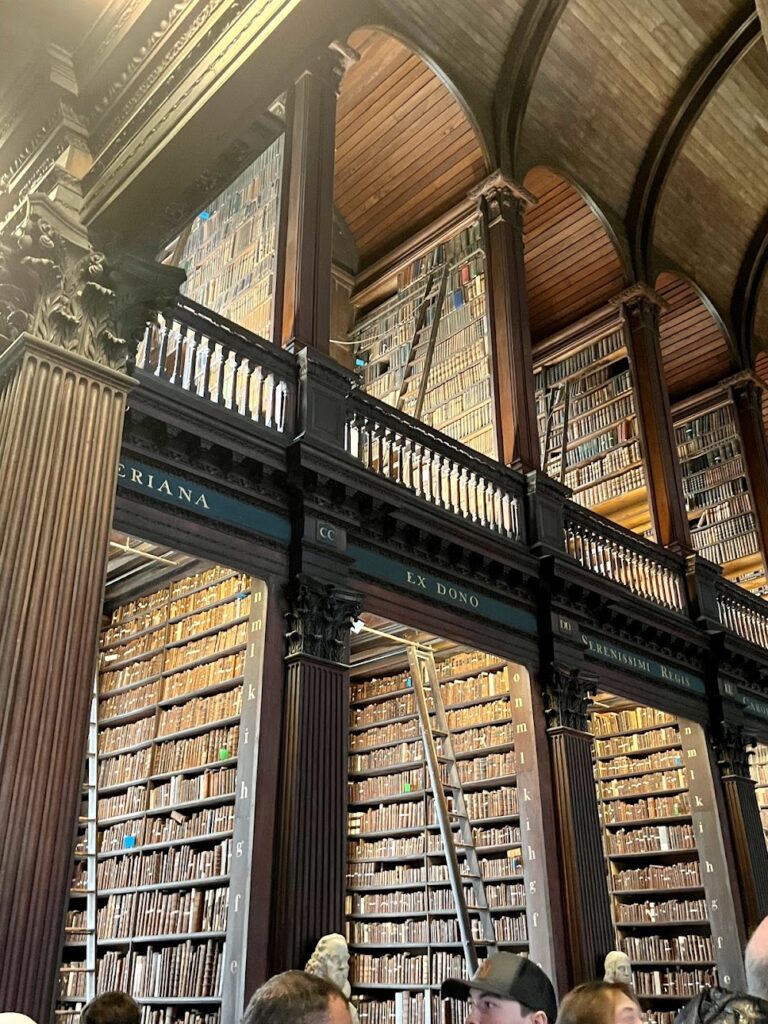This Week’s Bit of String: A library visit and hometown changes
On the first day of my summer visit from old England to New, I went to the library with my mother. It’s recently been refurbished in my hometown. The children’s area boasts a full play kitchen, and a teen reading room features a whiteboard table for doodling. On top of the bookshelves in the grown-up section, a community craft exhibit includes three-dimensional scrapbooked cards, patchwork quilts, carvings of birds, embroidered landscapes, and a whole felted ark full of animals.
What a lovely place. I did wonder, though, as Mom and I left, “What happened to that mysterious cabinet of dolls that used to be at the back of the library when I was a kid?”
She responded, “I keep wondering what happened to the collection of international creches at the Catholic shrine after it was bought out.”
Another good question. The lakeside Catholic retreat in town ran out of funds and was bought out by the Shaker Museum across the street, an ironic reversal of fortunes which I may revisit in a later post because there’s an intriguing story at the heart of it.
For our purposes this week, suffice to say that the Catholic site had a Christmas specialty. They ranged an immense collection of lights along their hillside. Coming home on a December night, we’d see them reflected in the lake from a couple miles away. They also took donations of nativity sets from all around the world, many of them beautifully crafted.
It’s funny how objects that may not have tangibly impacted us can anchor in our minds and resurface later. As writers, we’re often character-driven and particularly fascinated with people. But lately, I’ve noticed inanimate objects asserting importance in my short stories. What does it mean?
Living in a Material World
For me, writing a short story has generally included a central image, which may well be a natural or material object. Mudpies, a book of mazes, lipstick. Usually these are sort of thematic, whereas lately they’re practically plot points.
In the past year, I wrote a story about a fairground tragedy involving a ferris wheel, and the wheel additionally functions as a wider symbol. Another story currently on submission is about a family, each child represented by a colour from the gumballs in a vintage candy machine. Two decades of mid-twentieth century history are magnified through the machine’s glass sphere.
In real life, I’ve tended to wax sentimental over objects. After moving house when I was 8, I carried a little box of favourite things with me everywhere. A stone from the lake where we used to live, a broken necklace charm from a long-distance relative, I can’t even remember what else. When called upon to correct a sentence on the blackboard, I didn’t leave my seat without my box. I dropped it once and scrambled on the floor in front of my new classmates to gather my treasured crumbs.
Objects stand in for people in my mind. One of the many details I plan regarding my summer trip is coordinating my contact lenses. I wear monthly ones, and I always time the changing of them so that I put new ones in on the last day with my family. That way, I can linger for longer back in the UK with lenses that have “seen” my loved ones. It’s silly, but I’ve not been able to shake that symbolism.
Object Permanence
Maybe I am holding back a bit from attaching deeply to characters in a short story, placing a central object between us for distance. Will that impede the reader’s experience? We’ll have to see. It’s a new angle from which to look at characters—how they handle objects in their lives can tell us a lot.
It’s not as if this is wholly without literary precedent. Objects are important in children’s literature. A glass slipper, a golden ticket…A wardrobe becomes a new world, a boxcar becomes a home, dolls come to life. I remember a book in our church library about a penny. Each chapter focused on a new owner of that penny, from a child abducted by native Americans to an enslaved boy running toward freedom.
What could objects say about us, if they could speak? We did an assignment like that in our Journal As Literature college class. A friend wrote from the point of view of the socks she always wore to bed. I wrote about the teddy bear I’d bought my baby from London, to connect them to their then-estranged father. If I’m remembering correctly, I think the bear assessed me as guilty of some misplaced sentimentality, but he felt compassion for me too. Of course he was compassionate; he’s a teddy bear.
What would you write about? If your main character had to flee with a handful of possessions, what would they take?





